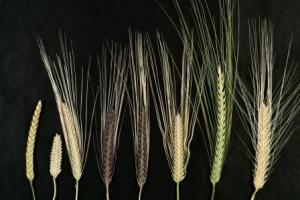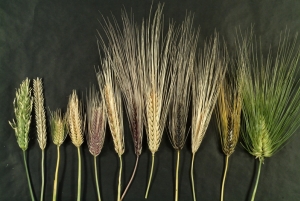Characterization of cultivated barley and wild relatives genetic resources
Contributors to this page: ICARDA, Syria (Ahmed Amri, Bilal Humeid, Kenneth Street, Natalya Rukhkyan, Jan Konopka, Siham Asaad, Adnan Omran and Fida Alô).
|
Contents: |
Planting and cultural practices for characterization
|
Characterization and evaluation of barley accessions in the field (photo: ICARDA) |
Environment
For cultivated species
- Plant preferably in a Mediterranean-type climate (semi-arid to favourable environment) with possibilities for irrigation under excessive drought (barley can grow in all types of soils but excess water might cause lodging).
- Plant taking into consideration the vernalization requirements of the genetic material, as well as the required cold tolerance levels.
- Irrigate the field directly after sowing if first rain is delayed. Supplementary irrigation can be applied as necessary to ensure adequate seed yield.
For barley wild relatives
- These must be grown under controlled conditions (because they are exotic species).
Soil type
- Alkaline heavy soils e.g. clay or clay loam with good drainage (barley can grow in many soil types).
Rainfall
- >350 mm.
Season
- Plant in the autumn (mid-November to mid-December in the CWANA region) except for spring and cold-susceptible varieties, which should be planted in the spring (mid-February to early April (in the CWANA region).
Plot size
- 2 rows, 2 m long, 45 cm between adjacent plots.
Sampling area/border area
- 1.5 m between neighbouring plots (to allow the scoring of individual plots and avoid mixing by lodging).
Plant density
- 250-300 seeds per m2.
Replications
- Normally un-replicated entries with control varieties regularly replicated (replication of control varieties only is sufficient for normal assessment of highly heritable morpho-agronomic traits; this is more economical and thus allows the screening of more accessions).
- For special purpose characterization, for more rigorous statistical analysis, full replication is necessary.
Standard check cultivars
- Arta, Rihane 03, Tadmor, Harmal, Radical (used in the CWANA region).
Frequency of standard checks
- Random or after every 20 accessions.
Time of day for data collection
- Between 8 am (08:00) and 12 pm (24:00).
Descriptors
Morphological descriptors for characterization
- See list for barley descriptors developed by IPGRI, 1994 (now Bioversity International) and list of key access and utilization descriptors developed by Bioversity International and International Centre for Agricultural Research in the Dry Areas (ICARDA) (2009).
Pictures for characterization
Sufficient detail should be captured in images to taxonomically identify the plant and demonstrate the traits that show variation.
- Take images for character(s) which may be difficult to describe verbally.
- Store in a database file linked to other characterization data.
 |
 |
|
Showing the diversity of panicles in images: On the left, two rows barley; on the right, six rows barley (photos: ICARDA) |
|
Herbarium samples for characterization
- It is suggested they should be taken and stored for future reference during multiplication/regeneration, particularly for primitive and wild relatives (to verify the accession identity and to be used as reference material).
Molecular descriptors for characterization
- SSR, EST-SSR, AFLP, RAPD (these are the current more efficient techniques for genetic diversity analysis and to look for duplicates).
Cytological characterization
- This type of characterization should be done in specialized laboratories.
Nutritional traits for characterization
The current most accurate and reliable methods are:
- Crude protein content.
- NDF and ADF.
- β-glucane analysis.
Recording information during characterization
- Reference to the trials (details of which will be stored in a separate database with information on dates, place, trial layout, persons in charge of trial, etc.).
- Fields selected from the barley descriptors list.
References and further reading
Bioversity International, ICARDA. 2009. Key access and utilization descriptors for barley genetic resources. Bioversity International, Rome, Italy; International Center for Agricultural Research in the Dry Areas, Aleppo, Syria. Available here.
IPGRI. 1994. Descriptors for barley (Hordeum vulgare L.). International Plant Genetic Resources Institute, Rome, Italy. Available here (1.1 MB).
Comments (1)
-
Guest - Tegegnework Wondwossen
Dear sirs/Madam
My misunderstanding in this barley descriptor is how to count spikelets per spike of irregular barley. What I do is, I count one row and multiply it by two and I record the result. In the case of six-rowed barley, I count one row of spikeletes and multiply it by six and record the result i.e if all spikelets are fertile. Am I correct or not ?0 Like



 Characterization
Characterization

Leave your comments
Post comment as a guest